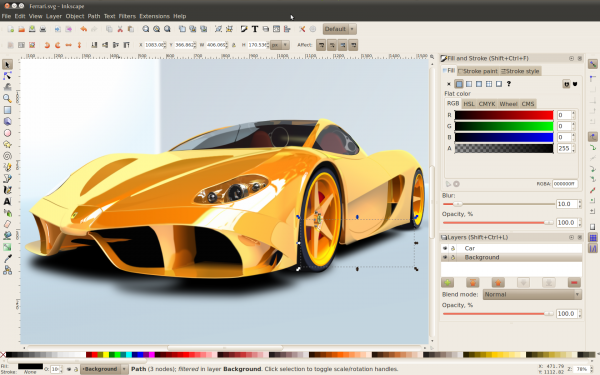Useful Open Source Software: Inkscape
update 6/11/2024: this is a post from a blog that I contributed to in 2011 called TechHacking, it shut down eventually but I was happy to be able to find some of my work through the internet archive.
Inkscape is a free and open source Scalable Vector Graphics (SVG) Editor. It it similar to Adobe Illustrator. While it lacks some of the more advanced features of proprietary SVG editors, it still has stunning capabilities allowing you to make brilliant drawings and graphics.
Vector Graphics are basically resolution-independent graphics, in comparison to bitmap graphics which are always bound to their pixels, vector graphics are stored through a mathematical formula in lines, shapes, and colors allowing them to become virtually any size without losing their quality – hence the term scalable (in SVG). Vector graphics can be very useful when developing logos and banners for your website.

Inkscape has recently released a new version (0.48.1) which will be available for download soon. Some new features in version .48 include:
- An improved text tool which allows you to add subscript, superscript, spacing, rotation and more
- Ability to edit multiple paths
- A spray tool (which is demonstrated in the picture above)
- Takes advantage of multi-threading for the Gaussian Blur filter
The new features in 0.48.1 build upon the already wonderful program. As this program continues to be developed in an open source environment, it will be exciting to see its growth. In addition to GIMP and several other graphic design programs (to be covered soon), Inkscape adds a significant piece of software to open source graphical editing capabilities allowing you to create professional graphics without spending any money on software or licenses.
Inkscape is available for download for Mac OSX, Windows, and Linux. If you do any sort of graphic design or have been wanting to try out working with vector graphics, download it today and you will not be disappointed. If you are new to SVG, there are tons of awesome tutorials and guides available to help you get started.
Thank you for reading! Share your thoughts with me on bluesky, mastodon, or via email.
Check out some more stuff to read down below.
Most popular posts this month
- Great Lakes, Illinois
- My Custom Miniflux CSS Theme
- SQLite DB Migrations with PRAGMA user_version
- Ladybird on Debian Stable
- Are we inside a Sarlacc?
Recent Favorite Blog Posts
This is a collection of the last 8 posts that I bookmarked.
- Clicks Communicator from Chris Hannah
- A Year Of Vibes from Armin Ronacher's Thoughts and Writings
- Pluralistic: A perfect distillation of the social uselessness of finance (18 Dec 2025) from Pluralistic: Daily links from Cory Doctorow
- Moving from WordPress to Substack from charity.wtf
- Grow, Like a Tree Not a Cancer from Jim Nielsen’s Blog
- Pluralistic: All the books I reviewed in 2025 (02 Dec 2025) from Pluralistic: Daily links from Cory Doctorow
- DEP-18: A proposal for Git-based collaboration in Debian from Optimized by Otto
- [RIDGELINE] No Phones in The Ten-don Shop from Craig Mod — Writer + Photographer
Articles from blogs I follow around the net
Clicks Communicator
Clicks: A new kind of mobile communicator Designed for doing, not doomscrolling. That tagline definitely got my attention. Based on the design and some of the copy, it made me think it was a more...
via Chris Hannah January 3, 2026Reminder: New Year, New URL
I mentioned it in the last post: To give this blog a more personal touch, I switched the URL to https://soeren.one. If you access through RSS feeds, bookmarks, or saved links, please take a moment to update them so you don’t miss any future posts. Thank you…
via gluecko.se January 3, 2026Ink in the Stomach
Something I believe very strongly, mostly from observing changes in myself, is that, once you’ve shoved your own hands deep in the entrails of a building, you’ve permanently altered your entire relationship with the world.
via The Map is Mostly Water January 3, 2026Generated by openring